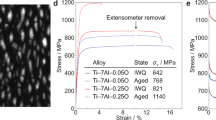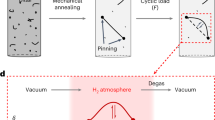Abstract
Structural components that operate at high temperatures (for example, turbine blades) rely on thermally grown oxide (TGO), commonly alumina, for corrosion protection. Strains that develop in TGOs during operation can reduce the protectiveness of the TGO1. However, the occurrence of growth strains in TGOs, and mechanisms that cause them, are poorly understood. It is accepted that compressive strains can develop as oxygen and metal atoms meet to form new growth within constrained oxide2,3. More controversial is the experimental finding that large tensile stresses, close to 1 GPa, develop during isothermal growth conditions in alumina TGO formed on a FeCrAlY alloy4. Using a novel technique5 based on synchrotron radiation, we have confirmed these previous results, and show that the tensile strain develops as the early oxide, (Fe,Cr,Al)2O3, converts to α-Al2O3 during the growth process. This allows us to model the strain behaviour by including creep and this diffusion-controlled phase change.
This is a preview of subscription content, access via your institution
Access options
Subscribe to this journal
Receive 12 print issues and online access
$259.00 per year
only $21.58 per issue
Buy this article
- Purchase on Springer Link
- Instant access to full article PDF
Prices may be subject to local taxes which are calculated during checkout




Similar content being viewed by others
References
Evans, A. G., Mumm, D. R., Hutchinson, J. W., Meier, G. H. & Pettit, F. S. Mechanisms controlling the durability of thermal barrier coatings. Prog. Mater. Sci. 46, 505–553 (2001).
Rhines, F. N. & Wolf, J. S. The role of oxide microstructure and growth stresses in the high-temperature scaling of nickel. Metall. Trans. 1, 1701–1710 (1970).
Clarke, D. R. The lateral strain accompanying the formation of a thermally grown oxide. Acta Mater. 51, 1391–1407 (2003).
Tortorelli, P. F., More, K. L., Specht, E. D., Pint, B. A. & Zschack, P. Growth stress-microstructure relationships for alumina scales. Mater. High Temp. 20, 303–310 (2003).
Hou, P. Y., Paulikas, A. P. & Veal, B. W. Growth strains and stress relaxation in alumina scales during high temperature oxidation. Mater. Sci. Forum 461–464, 671–680 (2004).
Sarioglu, C. et al. The adhesion of alumina films to metallic alloys and coatings. Mater. Corros. 51, 358–372 (2001).
Cho, J., Wang, C. M., Chan, H. M., Rickman, J. M. & Harmer, M. P. Improved tensile creep properties of yttrium- and lanthanium-doped alumina: a solid solution effect. J. Mater. Res. 16, 425–429 (2001).
Schumann, E., Yang, J. C., Graham, M. J. & Rühle, M. Segregation studies of oxidized yttrium- and zirconium-doped NiAl. Werkst. Korros. 46, 218–222 (1995).
Pint, B. A. & Alexander, K. B. Grain boundary segregation of cation dopants in α-Al2O3 scales. J. Electrochem. Soc. 145, 1819–1829 (1998).
Specht, E. D., Tortorelli, P. F. & Zschack, P. In-situ measurement of growth stress in alumina scale. Powder Diffr. 19, 69–73 (2004).
Prescott, R., Mitchell, D. F. & Graham, M. J. A study of the growth of α-Al2O3 scales using high resolution imaging secondary ion mass spectrometry. Corrosion 50, 62–71 (1994).
Noyen, I. C. & Cohen, J. B. Residual Stress Measurement by Diffraction and Interpretation (Springer, New York, 1987).
Acknowledgements
This research was sponsored by the US Department of Energy, BES, Materials Science, under contract Nos W-31-109-ENG-38 and DE-AC03-76SF00098.
Author information
Authors and Affiliations
Corresponding author
Ethics declarations
Competing interests
The authors declare no competing financial interests.
Rights and permissions
About this article
Cite this article
Veal, B., Paulikas, A. & Hou, P. Tensile stress and creep in thermally grown oxide. Nature Mater 5, 349–351 (2006). https://doi.org/10.1038/nmat1626
Received:
Accepted:
Published:
Issue Date:
DOI: https://doi.org/10.1038/nmat1626
This article is cited by
-
Fatigue Life Prediction Study for Vane Thermal Barrier Coatings Based on an Axisymmetric Model and Genetic Algorithm
Journal of Thermal Spray Technology (2022)
-
Oxidation Behavior of Oxide Dispersion-Strengthened W–Ni Alloys
Oxidation of Metals (2020)
-
Effect of Zr on Initial Oxidation Behavior of FeCrAl Alloys
Oxidation of Metals (2020)
-
Acoustic Emission and Associated Damage Mechanism Analysis in 8YSZ Thermal Barrier Coatings Under Instrumented Indentation
Journal of Thermal Spray Technology (2019)
-
Application of Acoustic Emission Technology for Quantitative Characterization of Plasma-Sprayed Coatings Subjected to Bending Fatigue Tests
Journal of Thermal Spray Technology (2018)



